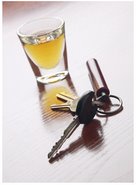Diabetics commonly experience hypoglycemia (low blood sugar levels). And what are the symptoms? Slow and slurred speech, poor balance, impaired motor control, staggering, drowsiness, flushed face, disorientation -- in other words, the classic symptoms of alcohol intoxication. This individual will look and act like a drunk driver to the officer, and will certainly fail any DUI "field sobriety tests". As one expert has observed, "Hypoglycemia (abnormally low levels of blood glucose) is frequently seen in connection with driving error on this nation’s roads and highways...Even more frequent are unjustified DUIs or DWIs, stemming from hypoglycemic symptoms that can closely mimic those of a drunk driver." From "Hypoglycemia: Driving Under the Influence" in 8(1) Medical and Toxicological Information Review Sept. 2003.
Canadian scientists have reported that "approximately 200 compounds have been detected in the human breath." Manolis, The Diagnostic Potential of Breath Analysis, 29(1) Clinical Chemistry 5 (1983).
This study confirmed the presence of acetone on the breath in diabetics and in persons on a diet " associated with a weight reduction of about one-half pound per week." Id. at 9. Another study has confirmed that diabetics may give false indications of intoxication. In Brick, Diabetes, Breath Acetone and Breathalyzer Accuracy: A Case Study, 9(1) Alcohol, Drugs and Driving (1993), a researcher found that expired ketones in the breath of an untreated diabetic can contribute to erroneously high breath-alcohol readings. Further, the acetone on the breath from ketoacidosis will result in an odor of alcohol. Finally, behavioral patterns of a diabetic whose blood-sugar level has dropped will include slurred speech, slow gait, impaired motor control, fumbling hand movements, and mental confusion--all symptomatic of intoxication.
Acetone may also be found on the breath of perfectly normal, healthy individuals. Yet, acetone is one of the compounds that will be detected on many breath analyzing instruments as ethanol. In the Intoxilyzer, for example, it is detected because acetone absorbs infrared energy in the 3.38 to 3.40 micron range--the same range where ethanol is found. Therefore, if acetone were introduced into the Intoxilyzer, the machine would simply register the presence of alcohol despite its absence. If an individual had 525 micrograms per liter of acetone in the breath, he would register a blood-alcohol level of .02 to .03 percent. Thus, if an individual with a true blood-alcohol level of .08 percent had that amount of acetone, the Intoxilyzer would register in the area of .l0 to .11 percent.
The National Highway Traffic Safety Administration has published a report entitled The Likelihood of Acetone Interference in Breath Alcohol Measurement (DOT HS--806-922). The report basically summarizes scientific literature on the subject, concluding that normal individuals have insignificant levels of acetone on their breath. The data indicated, however, that dieters can have higher levels and that diabetics not in control of their blood-sugar had levels hundreds or even thousands of times higher than normal
a study confirming the effects of acetone in diabetics can be found in Mormann, Olsen, Sakshaug, and Morland, Measurement of Ethanol by Alkomat Breath Analyzer; Chemical Specificity and the Influence of Lung Function, Breath Technique and Environmental Temperature, 25 Blutalkohol 153 (1988). Diabetic subjects in that study also were found to have acetone levels sufficient to produce breath-alcohol readings of .06 percent.
Breath testing machines, such as the Intoxilyzer 5000, suffer from a little-known design defect: they do not actually measure alcohol! Rather, they use infrared beams of light which are absorbed by any chemical compound (including ethyl alcohol) in the breath which contains the "methyl group" in its molecular structure; the more absorption, the higher the blood-alcohol reading. The machine is programmed to assume that the compound is "probably" alcohol. Unfortunately, thousands of compounds containing the methyl group can register as alcohol. One of these is "acetone". And a well-documented by-product of hypoglycemia is a state called "ketoacidosis", which causes the production of acetones in the breath. In other words, the Breathalyzer will read significant levels of alcohol on a diabetic’s breath where there may be little or none. See, for example, Brick, "Diabetes, Breath Acetone and Breathalyzer Accuracy: A Case Study", 9(1) Alcohol, Drugs and Driving (1993).
Fact: roughly one in seven sober drivers on the road suffers from diabetes.
Subscribe to:
Post Comments (Atom)


1 comment:
my breath tested as .13 but i had 3 heinekens over the course of 3-4 hours. too bad i didn't research this sh*t before i went driving. now, i am so f***'ed
Post a Comment